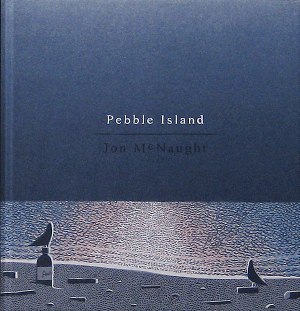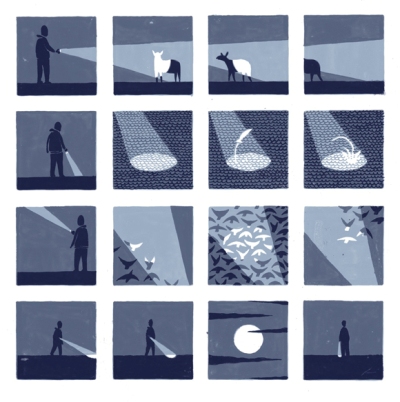Pebble Island & Birchfield Close
Reviewed by Peter Campbell 16-Jun-11
These two short books by Jon McNaught are an unexpected pleasure. From a distance they resemble stocking filler books, the sort you flip through and then consign to your local charity shop. In actuality, they contain unusual, rather striking comics which have a quality I haven’t really seen in the medium before.
These two short books by Jon McNaught are an unexpected pleasure. From a distance they resemble stocking filler books, the sort you flip through and then consign to your local charity shop. In actuality, they contain unusual, rather striking comics which have a quality I haven’t really seen in the medium before.
Virtually wordless, both comics contain stories with common elements. They concentrate on landscape rather than character and are made up of small, generally symmetrical panels with a limited palette of two or three colours. Each page is composed as a compositional whole – you could take any one, blow it up in size, and you’d have a rather stunning print. They also tend to be self-contained: although a narrative flows between panels, it’s one that seldom spills from one page to the next.
Birchfield Close is the earlier work of the two (or at least the first to be published). Set in a suburban housing estate, it’s an almost entirely observational piece. Two teenagers climb on top of the roof of one of the houses and watch the events in the neighbourhood: a flock of birds pass; someone falls off their bicycle; someone mows the grass. Speech balloons are used, but they’re used in a way that’s subsumed to the overall page design. They record not speech but sound – dialogue on a television, a song lyric on a radio, the everyday sounds of household life. It’s a cool, rather distanced perspective, and is all about highlighting small details that exist in the wider setting.
Pebble Island is made of up two separate stories. ‘Peat Bog’ is set in rather bleak countryside, in which a boy leaves his house to meet up with his friends. Together they travel to a peat bog where he blows up his toy dinosaur. Along the way he feeds fish kept in an old tyre, investigates an abandoned van, and disturbs watching sheep. As with Birchfield Close, it’s told in a detached fashion, with the landscape dominating the proceedings. Its still, linear, entirely wordless and, at times, extremely beautiful.
The second story, Broadcast, is more experimental still, intercutting between an Indiana Jones film shown on TV, and (once again) landscape. It reminds me of the tricky narrative experiments you’d see Spiegelman producing during his Arcade days. It also features, for the first time, faces in comparative closeup, where they betray a distinct Raymond Briggs influence. It points the way, perhaps, to McNaught producing a less remote narrative, with a greater concentration on character.
It’s interesting to read that McNaught studied printmaking, and I suspect it’s this very perspective that makes his art so striking. It’s early days, but on the strength of these two books, I think he could develop into a significant figure in the comics medium. It’ll interesting to see where he goes next, but in the meantime, these two intriguing and rather haunting works are well worth seeking out.
Tags: John McNaught, Nobrow Press

That page is wonderful. Thanks for covering this title.